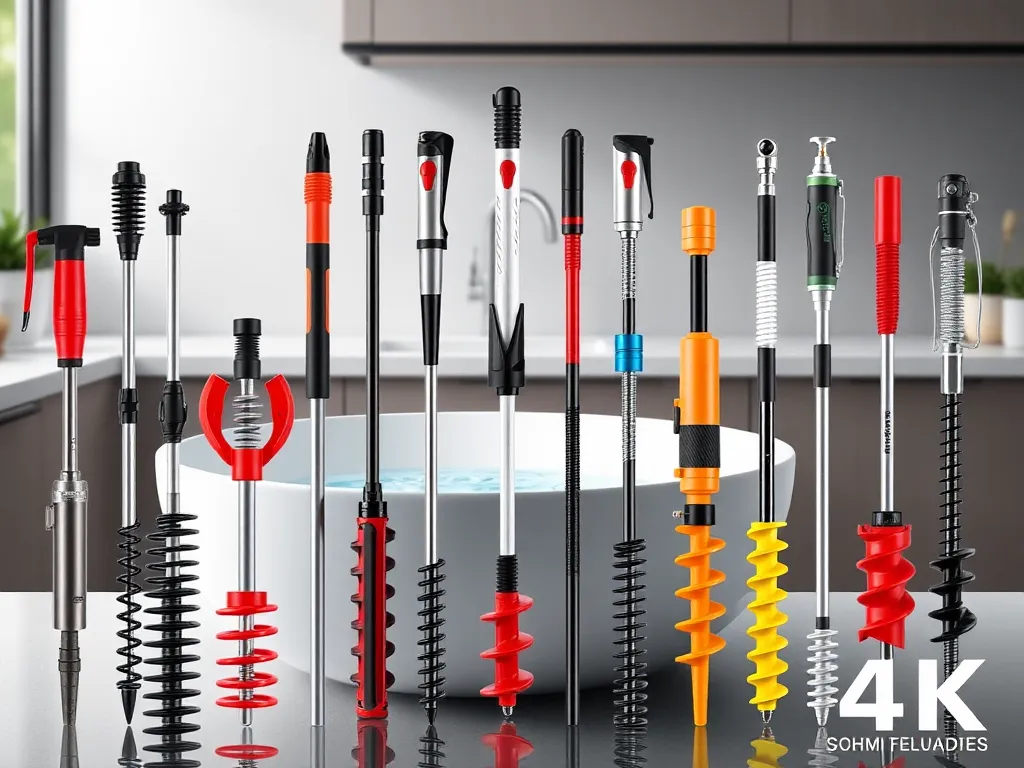10 Best Plumbing Augers for Unclogging Drains

The Ultimate Guide to Plumbing Auger: Everything You Need to Know
Plumbing auger is a versatile tool used for unclogging drains and removing obstructions in plumbing systems. Whether you're dealing with a stubborn clog in your kitchen sink, bathroom shower, or toilet, a plumbing auger can come to the rescue. In this comprehensive guide, we'll explore the different types of plumbing augers, the key features to consider when choosing one, how to use it effectively, tips for unclogging drains, common mistakes to avoid, and important safety precautions.
Types of Plumbing Augers
There are several types of plumbing augers available in the market, each designed for specific purposes. Let's take a closer look at each type:
1. Handheld Plumbing Augers: Also known as drum augers or hand snakes, these are the most basic types of plumbing augers. They consist of a coiled metal wire or cable encased in a drum-like container. Handheld augers are ideal for unclogging sinks, showers, and tub drains. They are easy to use and can reach up to 25 feet in length.
2. Drain Snake Augers: Drain snake augers are longer and more flexible compared to handheld augers. They are typically used for unclogging main sewer lines and outdoor drains. Drain snake augers can range from 25 to 100 feet in length and are capable of navigating through complex plumbing systems to reach the clog.
3. Toilet Augers: As the name suggests, toilet augers are specifically designed for unclogging toilets. They feature a long, flexible cable with a bend at the end to navigate through the curves of the toilet trap. Toilet augers are highly effective in clearing stubborn toilet clogs without causing damage to the porcelain.
4. Power Augers: Power augers, also known as electric augers or sewer machines, are heavy-duty tools used by professional plumbers. They are powered by electricity or gasoline and can clear even the toughest clogs. Power augers are typically used for large-scale plumbing projects and can reach up to 200 feet in length.
Features to Consider when Choosing a Plumbing Auger
When choosing a plumbing auger, there are several important features to consider:
- Length and Diameter: The length and diameter of the auger cable determine its reach and flexibility. Longer cables are suitable for unclogging main sewer lines, while shorter ones are ideal for smaller drains. The diameter should match the size of the drain to ensure effective unclogging.
- Material: Look for an auger made of high-quality materials like steel or carbon fiber. These materials are durable and resistant to corrosion, ensuring a longer lifespan for your auger.
- Cable Rotation: Some augers feature a rotating cable, which helps to break up clogs more effectively. Consider opting for a model with this feature for better results.
- Handle Grip: A comfortable handle grip is essential for easy maneuverability and control. Look for an auger with a non-slip and ergonomic handle.
- Compatibility: Ensure that the auger you choose is compatible with the type of drain you need to unclog. Different augers are designed for different types of drains, such as sinks, showers, tubs, or toilets.
How to Use a Plumbing Auger
Using a plumbing auger requires proper technique and caution. Here's a step-by-step guide on how to use it effectively:
1. Locating the Clog: Identify the location of the clog by observing the drain's behavior. Is the water draining slowly or not at all? This will help you determine where to insert the auger.
2. Inserting the Auger: Carefully insert the auger into the drain opening, ensuring that the cable goes in smoothly. Do not force it as this may cause damage to the plumbing.
3. Rotating and Pushing: Once the auger is inserted, rotate the handle clockwise while gently pushing the cable forward. This will help to break up the clog and clear the drain.
4. Removing the Auger: After clearing the clog, slowly retract the auger while continuing to rotate the handle. This will prevent any debris from getting stuck in the drain.
5. Cleaning and Maintenance: Once you've finished using the auger, clean it thoroughly with water and a mild detergent. Ensure that the cable is completely dry before storing it to prevent rusting.
Tips for Unclogging Drains with a Plumbing Auger
Here are some helpful tips to keep in mind when using a plumbing auger:
- Start with a Plunger: Before using an auger, try using a plunger to loosen the clog. Plunging can often dislodge minor obstructions without the need for an auger.
- Use Proper Technique: Follow the instructions provided with the auger and use the proper technique to avoid damaging the plumbing or injuring yourself.
- Be Patient: Unclogging a drain may take some time and multiple attempts. Be patient and persistent.
- Wear Protective Gear: Always wear protective gloves and safety goggles to protect your hands and eyes from any debris or splashes.
- Preventive Maintenance: Regularly maintain your plumbing system to prevent clogs from occurring in the first place. This includes avoiding pouring grease or oil down the drains and using drain screens to catch hair and other debris.
Common Mistakes to Avoid when Using a Plumbing Auger
To ensure a successful unclogging process, avoid the following common mistakes:
- Using Too Much Force: Excessive force can damage the plumbing pipes or push the clog further down. Use gentle pressure and let the auger do the work.
- Not Following Instructions: Each auger may have specific instructions or recommendations for use. Make sure to read and follow them carefully to avoid any mishaps.
- Using the Wrong Auger: Using an auger designed for a different type of drain may not yield effective results. Always use the right auger for the specific drain you are unclogging.
- Not Cleaning the Auger: After each use, clean the auger thoroughly to remove any debris or residue. Failing to do so can reduce its effectiveness and even lead to rusting.
Safety Precautions when Using a Plumbing Auger
To ensure your safety while using a plumbing auger, follow these precautions:
- Wear Protective Gloves: Protect your hands from any sharp edges or debris by wearing thick gloves.
- Protect Your Eyes: Safety goggles or glasses can prevent any debris or splashes from entering your eyes.
- Avoid Contact with Chemicals: If you have used any chemical drain cleaners before using the auger, make sure to rinse the drain thoroughly. Chemicals can be hazardous and may react with the auger.
- Ensure Proper Ventilation: If you are using a power auger indoors, make sure the area is well-ventilated to prevent the buildup of harmful fumes.
- Keep Children and Pets Away: Keep children and pets away from the area while using the auger to avoid accidents or injuries.
